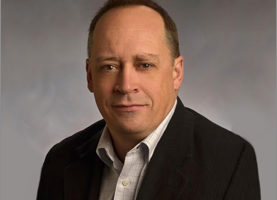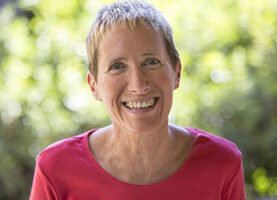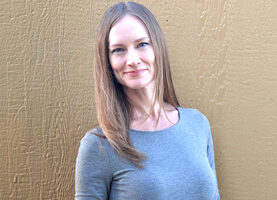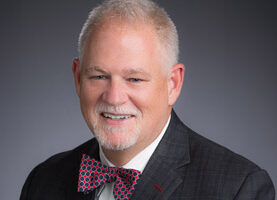
Support Us
Donations will be tax deductible
Kenneth & Blaire Mossman Professor of Microbiology, Steven W. Wilhelm, joins the show to talk about cyanobacteria, the problems presented by blue-green algae blooms, and the research he’s conducting in the lab.
In this episode, you’ll learn:
Cyanobacteria is responsible for carrying out more than 25% of the photosynthesis on the planet, which means that about one out of every four breaths of oxygen you take is thanks to these single-celled bacteria that can be found in abundance in every aquatic system in the world. But what happens when there’s too much growth of cyanobacteria, and what causes overgrowth?
Wilhelm explains that concerning algal blooms are driven primarily by human activity—specifically those activities which result in high levels of nutrients such as nitrogen and phosphorus being pumped into the environment and contributing to rapid population increases in cyanobacteria.
When this happens, the algal blooms that form fundamentally change the water systems they are in by pushing out algae that may be better fish food, and producing toxins called microcystin and other compounds which can be harmful to other species, including humans. When these blooms die, they become food for heterotrophic bacteria that consume oxygen. As a result of this, “dead zones” form, which have significant impacts on fish habitat and other forms of aquatic life.
So, what can be done about this problem? Wilhelm and the team at his lab spend a lot of time sequencing RNA and DNA in order to investigate why different organisms emerge under different circumstances. The hope is that with a better understanding of why cyanotoxins do so well under certain conditions (as opposed to more beneficial algae), it will be possible to intervene with a treatment or other method and prevent or limit further growth.
Tune in for all the details and visit http://wilhelmlab.utk.edu/ to learn more.
Available on Apple Podcasts: apple.co/2Os0myK
Richard Jacobs: Hello, this is Richard Jacobs with the Finding Genius podcast. I have steven W. Wilhelm. He is a professor of microbiology at the University of Tennessee. He is also part of the aquatic microbial ecology research group in the Department of Microbiology and we are going to talk about cyano-bacteria and their blooms and what that does to the whole environment around them. So, Steve, thanks for coming.
Steven W. Wilhelm: Thanks for having me.
Richard Jacobs: There are people that don’t know what is cyano-bacteria, where are they, and what role they have in the environment?
Steven W. Wilhelm: Sure, so cyano-bacteria or some people may know them as blue-green algae are single-cell bacteria that can carry out photosynthesis in a manner analogous to higher plants. So they fix carbon from carbon dioxide into biomass and grow. They are abundant in every aquatic system around the world and they are actually some of the most abundant organisms on the planet.
Richard Jacobs: So, they photosynthesize carbon. Who eats the cyano-bacteria or where does it go from there once they’ve done the photosynthesis?
Steven W. Wilhelm: So, just like small single-cell algae we would think of like diatoms and smaller carious, in many cases, these are grazed on by smaller vertebrates. In other cases, they are caught up in filter-feeding. In part, it depends on the cyano-bacterium in question and there is a really broad spectrum of these. Some are more palatable than others and then some are killed by viruses in these systems as well.
Richard Jacobs: so, who is the main predator if the cyano-bacteria and who benefits from the results of their photosynthesis mostly?
Steven W. Wilhelm: I would have to say we benefit a lot from the results of photosynthesis. If we estimate the cyano-bacteria are carrying out as much as a quarter of the photosynthesis on the planet. So, one out of every four breaths that we take may be the result of cyanobacterial photosynthesis. In terms of their main predator, if we look at cyano-bacteria in the oceans, their main predator could possibly be viruses. We think that half the mortality in the oceans of cyano-bacteria is due to viruses. We don’t have similar numbers for freshwaters, that’s a little bit more complicated. We have different types of cyano-bacteria, we know that there are viruses there but freshwater systems are often full of small and wood ward grazers. Little proteus that would consume them.
Richard Jacobs: The oxygen that the cyano-bacteria make. I guess the water they are in, it’ll hold a very small amount of dissolved oxygen, so mostly that goes into the air. Is it freed?
Steven W. Wilhelm: That’s right and in fact, if we think back to the early earth when there was no oxygen, the first oxygen probably came from an ancient cyano-bacterium. So that oxygen accumulated with time. It reacted chemically with the earth but eventually, it was freed up and built up the concentration of oxygen we have in the atmosphere today.
Richard Jacobs: where do these guys live? Like, right on the surface or a few inches down. Where is their zone?
Steven W. Wilhelm: They live all over. They live up and down the water column. As long as there is light, they live and in the oceans that can be 120 to 200 meters deep. In freshwater systems, it depends on the lake in question, it could be 20 to 30 meters deep and you may be most familiar with them as some of the thick scums that can form on the surface when we have an algo-bloom, when they go out of control, then they’ll often live right at the surface forming a thick green mass.
Richard Jacobs: with the oxygen that they create do they; has it been observed that there are like micro-bubbles at the top 50 or 100 meters in the ocean because of them?
Steven W. Wilhelm: Yeah, so not in the ocean per se, but we have seen it in the lab where we’ve had experiments going on and again, especially with some of this freshwater cyano-bacteria where they are sitting under the perfect conditions. They have lots of light, lots of nutrients and you’ll actually start to see bubbles potentially forming in clumps of cyanobacteria. It’s p0retty spectacular when it happens.
Richard Jacobs: yeah, I think they would have a big influence on the chemistry of any body of water they are in. It will be very different above them and below them because of the presence of this dissolved oxygen and the bubbles, maybe there are all kinds of crazy reactions going on inside the bubbles, etc.
Steven W. Wilhelm: You are absolutely right. Where they maybe have a bigger impact is when they die because they go from being oxygen producers to food organisms that consume oxygen like heterotrophic bacteria. So, many of our dead zones, for example, I mentioned great lakes, Lake Erie has a massive dead zone that forms the summer. We think a lot of that has to do with the cyano-bacteria dying off, the carbon being transported down in the lake, and then bacteria consuming this cyano-bacteria and using up oxygen at the same time. That forms what we colloquially call a dead zone.
Richard Jacobs: So, are most of this cyano-bacteria eaten while they are alive or they are eaten when they are dead? How is eating them when they are dead different from eating when they are alive?
Steven W. Wilhelm: Yeah, when they are dead, they probably mostly just fall apart and breakdown. When they are alive, again, some of the small ones are eaten by invertebrate grazers but a lot of them are very unpalatable. Some of the organisms will go out of their way to avoid eating them. So when we study a lot Microcystis, it’s been shown that something like Zebra Mussels will actually spit them back out if they consume them. They are basically the equivalent of the pizza box of the lake system. There is a lot of material there that is just not very nutritious and hard to consume.
Richard Jacobs: what about fish though? Are they small enough for a fish, they would pass through and over a fish’s gills continuously because there are so many and they are so small?
Steven W. Wilhelm: That’s a really great question. You will see a lot of them go into the fish and pass over the gills. In fact, a few years ago, working with a colleague Ted Henry, we actually made videos of that because we were not convinced that it was happening. So, we had the students show that if fish take in some of this cyano-bacteria, they can actually escape out of the gills. At the same time, they can also end up in the stomach content and with certain cyano-bacteria, this becomes a problem because many of them make secondary metabolites that turn out to be toxic.
Richard Jacobs: It’s weird, they are everywhere, so just imagine the places that they’ll go and what they’ll do. So, when they form blooms, is it man-made reasons, or is there natural cycling where they do bloom and then diminish?
Steven W. Wilhelm: I think it’s a combination of both things, there are some environments that are just perfect for phototrophs to do very well but the blooms that we are really concerned about nowadays, the blooms that we’ve heard about like Lake Okeechobee, Lake Erie, Grand Lake, St. Mary’s in Ohio, Blooms Out in Oregon; we think that they are, for the most part, driven by human activity, by humans pumping nutrients into the environment like Nitrogen and Oxygen and Phosphorus that acts as food for algae. You pump in more nutrients; you get more algae.
Richard Jacobs: so, when there is an abundance of nutrients, they’ll bloom, and then what happens once they get into a certain number and I guess, overwhelm the systems that are around them and other creatures? In terms of fall out, what happens?
Steven W. Wilhelm: Yeah, they really fundamentally change the system they are in. They can overwhelm the other organisms that are there. They can push out algae that may be better fish food. As I mentioned they produce compounds like microcystin which was originally known as a fast death factor. Its name really tells you what it can do and fish will have to avoid that or not consume it. They can die off, these blooms and when they die off, they create these giant dead zones. So, they produce taste and odor compounds, compounds that make the water smell terrible and taste terrible and when there are toxins that get in drinking water supplies, it can sometimes become harmful to humans and there are a couple of cases where we have had to shut off water supplies in order to protect the population.
Richard Jacobs: When they die, do they float, or do they sink?
Steven W. Wilhelm: Yeah, when they die, they generally sink. Microcystis in particular, the main one that people are worried about these days, has the ability to control its own place in the water column. It can be buoyant, so it can float and if it doesn’t have enough light, it can float more, to move up into the water column to get more light. If it has too much light or maybe not enough nutrients, it will sink back down into the water column to where there are less light and more nutrients. So they can do that when they are living. When they are dead, for the most part, we think they are generally going to end up sinking out. Some of them just break open and fall apart but others will sink out to the bottom.
Richard Jacobs: Interesting. Do they form deterministic geometrics? When they are blooming or they are dying, do they form a cone or is there any learning to be done there? Can you tell the shape of death when they die en masse or when they bloom?
Steven W. Wilhelm: That’s a really cool question. You can see colors; so for example, because these are phototrophs, they contain chlorophyll and when they start to perhaps run out of nutrients which is sort of the first stage of bloom termination, at some point, they will turn chlorotic, they will turn yellow. We’ve seen this in places, in China, and in other places. What’s fascinating about that is we were actually in China a couple of years ago and there was a giant bloom of Microcystis that was a lake in China called Taihu, it’s very famous amongst Limnologists for being one these lakes that are heavily impacted and the bloom had gone bright yellow. A storm blew in, mixed up all the sediments, brought nutrients to the surface, and two days later the cells had gone back to green because they had this fresh infusion of food.
Richard Jacobs: That’s weird. What do you do once a bloom starts? If you keep feeding the bloom, the bloom only grows and it gets worse, if you stop feeding the bloom, then things die and cause other problems. So what do you do? You are taken, hostage.
Steven W. Wilhelm: Right. It is a bit of a problem. I think we want to prevent the blooms from starting in the first place and if you keep feeding the bloom, even though it would die off and cause some issues there, it at least would not get bigger. One of the problems we are having now is that what feeds the bloom are nutrients that drive food production, nutrient fertilizers we may see being used in golf courses, etc. and so forth and we need nutrients in the environment because we use it to generate our own food. In order to probably cut these nutrients off, I think it would be possible to do it but it would take some money and it would take some political will and right now, there doesn’t seem to be the economic or political will to sort of, stop this nutrient pollution going into this system. So we are really at an impasse. We have laws in place to try to reduce nutrient loads. Hopefully, some of those will take hold but as long as we keep dumping nutrients then these blooms are going to keep occurring.
There is more than just drinking water and oxygen at stake here. Bloom events will shut down beaches, that costs small communities a lot of money if you are a small town, maybe on the coast of Lake Erie and much of your income comes from the people coming to the beaches in Summer, having giant algo-blooms there is not a great way to attract tourists.
Richard Jacobs: Have you been able to compare the death state of a cyano-bacteria that was killed by phage versus one that was starved to death?
Steven W. Wilhelm: we have not done that specific comparison yet. People really started looking closely at viruses or phage or Microcystis about 5 or 6 years ago and my lab is actually one that does that. So, we become interested in just determining what the role of phage may be in this process. One of the side interests of that is that when a phage kills a cell, it tends to just kind of break it open and rip it apart and the toxin that Microcystis makes is generally maintained inside the cell until the cell dies. So, death by phage means that this toxin is getting out into the environment. That becomes a complication for humans because primary water treatment in many places, in large cities along these water bodies that are affected, could remove the toxin if it was in the cell or could remove the toxin if it was free and dissolved in the water column but the approaches are different. So, right now, one of those things that we are trying to understand is when do you get these phage events moving the toxin from the particulate or living pool into this free-floating dead pool materials.
Richard Jacobs: I wonder if you can introduce a flock event. I guess most of these bodies of water are so huge, I don’t know what you can do but I wonder if you could flock together the cyano-bacteria and then cause them to drop out of the column. Maybe that would help, I don’t know.
Steven W. Wilhelm: People have tried that with different clays before where they can go out, spray clay into the water and the trail flocculates and settles down to the bottom. But that’s just really a band-aid solution because it cleans things up for a day or two and then a few cells escape, they get back into the water column. There is no competition, there is lots of nutrients and light and they just take off and your bloom returns. So, often the flocculation approaches don’t work very well. You have to keep applying them over and over and that could get expensive quickly.
Richard Jacobs: When they are blooming, are they forming like a bio-film? Do they form a different structure, do they have different properties and metabolites when they are free-floating?
Steven W. Wilhelm: Yeah, so when these guys bloom and remember, the individual cells are only a couple of microns in size, they’ll often form colonies. So when we study them in the lab, they tend to form single cell physiologies and we see those in nature as well but sometimes we will see them in nature where they will form colonies of hundreds of individual cells. Scientists are really interested in this because we think that colony formation is key to their survival and key to their ecology. These colonies, when they are really big and some of the most robust ones you can see with the naked eye when you look at the water. So it’s usually pretty impressive to see a bloom like that.
Richard Jacobs: Yeah, I wonder if you can take advantage of their specific biology when they are in that state.
Steven W. Wilhelm: Yeah, we are working with colleagues in China to try to understand what causes them to form colonies versus single cells because when they form colonies, obviously they are all together in a bigger mass and it might be easier to remove them from the water that way.
Richard Jacobs: Interesting. So what are some other promising ways to stop the blooms once they happen and return the lakes and other bodies of water back to normal?
Steven W. Wilhelm: Well, I think that what we are trying to understand right now is what their major drivers are and for the last 50 years, everyone has sort of talked about nutrients so I’ve mentioned that a lot. We talk about nitrogen and phosphorus but what we found interesting is that the nutrients only really control how much of an organism is there, not what type of an organism appears. So, it’s possible the same amount of nutrients could give us diatoms which are great foods for smaller invertebrates that lead to fish. So, one thing we are trying to understand right now is why we get cyano-bacteria or Microcystis in the system as opposed to getting more beneficial algae. We think that this approach is going to bear some fruit because when we can start to understand why Microcystis is doing so well, maybe we can alter things a little bit to stop it from doing so well. Examples of things that make them do well, for example, are warmer waters. Cyano-bacteria grows much better in warmer waters and the diatoms it can fuse with. So climate change and increase in temperature, even a degree or two, can really shift the balance in the community. So, understanding that has become really important.
As well as when they compete for things like different types of nutrients. About 25 years ago, farmers switched from ammonium nitrate as a fertilizer to urea as a fertilizer and we think that switch which happens to coincide with when we started to see bloom issues may be an indicator of some advantage Microcystis has versus other organisms, just switching the type of nitro they are getting. So there are a lot of different questions, there are a lot of different approaches. When I talk to students about this, I normally say that it’s complicated and it’s much more complicated than we would like it to be.
Richard Jacobs: Yeah, biological systems are very complicated; I mean they can defend themselves and it’s really tough. Are there any insights when you get dead zones? Are they just monolithic or are they pockets of dead zones? Is there any intervention or so if you have a large dead zone that is very big, is that different from the small ones? Do they merge?
Steven W. Wilhelm: So, I think that’s a really interesting question because dead zones occur all around the world. There are dead zones that occur in the Gulf of Mexico, dead zones that form in the ocean, dead zones that form in large lakes, in systems around the world and dead zones, as I mentioned are really caused by an input of a lot of carbon that becomes food for bacteria that consume the oxygen. In the Great Lakes, we know that the dead zones date back to the 1930s and it’s become pretty clear that dead zones have become larger in more recent years, in the last 20 years. Why we care about dead zones is they can really mess with fish habitat. They can impair nurseries, they can impair breeding grounds, they can impair organisms that can be food or part of the food web. So, one thing we know about dead zones is that they are often really just driven by carbon load. That carbon load can be trussed for a one-off, it can be large balloons of algae dying off, so much of this is linked together.
So understanding how our role in driving nitrification or the dumping of nutrients in the systems that creates more primary productivity that leads to more fixed carbon, it leads to more respiration in the bottom, everything is kind of tied together.
Richard Jacobs: What’s happening; I mean this may be a stupid question but what’s in the dead zone? Are even the cyano-bacteria gone? Is there nothing there?
Steven W. Wilhelm: so, no, there is actually a lot of stuff there and I have a colleague who is at Kent State and he once corrected me. He said you shouldn’t call these dead zones; you should call them too alive zones. They are too alive because the bacteria are going crazy. It’s a smorgasbord for them. They are getting all sorts of carbon and all sorts of food, so they are just growing like crazy and that’s why they consume all of this oxygen. Now, there are degrees of that, I guess and degrees of oxygen availability where you can have oxygen concentrations drop, not all the way to zero and some organisms can tolerate that and can move in and out of there. At the same time, there are cell organisms that are sort of just stuck in a location.
So, they are probably doing their best to tolerate oxygen as it comes and goes or as it’s available in these systems as well. You can think of maybe clams or something, can’t really move too far. So, I guess the take-home message from the dead zones is that they are not what we would typically think of as a healthy ecosystem.
Richard Jacobs: what about using the huge abundance of cyano-bacteria for a job, to make oxygen or to use as food or something so you can get some use out of it. A lake that you know is going to have bloomed a bunch of times, what can you hook up to the lake and get some resource that would be beneficial?
Steven W. Wilhelm: You are right on track with many of the scientists and engineers over the last 20 years and I’ve been involved with projects that do this but really asking a question, how can we make something out of the cyano-bacteria where we can have some economic recovery that covers the cost of the cleanup and there are efforts out there to make machines that move through the water and consume the cyano-bacteria and turn it into fuel and you would turn it into fuel that would power that machine so that it wouldn’t cost you anything to run it. there are people in the UK working on this, people in North America and China working on this. No one has been really successful yet because of the costs. There are ways to go through it and clean up these cyano-bacterial blooms but just like the clay flocculation, they return a few days later and it becomes very expensive over time. If somebody could come up with that end product that had economic value, that you could then generate funds to pay for the harvesting of the Microcystis, then we might be on to something.
Richard Jacobs: Yeah, if you could just start sucking up water into a gigantic pump and pump it into a system where you can again, use it to sequester carbon en masse. Maybe it’s coupled with a machine that does that. I don’t know.
Steven W. Wilhelm: These organisms make all kinds of interesting chemicals, secondary metabolites and so, we have sat out there before, in the middle of Lake Erie which is a very large lake and just pumped water into the ship, collected the algae out of it and put the water back, for hours and hours, it doesn’t dent the bloom that’s out there because as you are putting the water back in, you are dumping back in all the nutrients that drive growth without the algae there. So you are really just feeding the ones that were left behind.
Richard Jacobs: is there any benefit to building up; like you said, you were pumping and pumping for hours and if you keep concentrating and concentrating the algae, do you get anything beneficial that you could use?
Steven W. Wilhelm: that’s what people keep trying to find. No one has come up with an economic product yet that really has a lot of benefits to it. there’s constantly people talking about it though.
Richard Jacobs: Okay, So what are you working on in particular? Any insights that you’ve been trying to generate in this whole problem?
Steven W. Wilhelm: So, my lab is sometimes a little bit defocused and we work on a number of different things. We are a molecular biology lab, we spend a lot of time sequencing DNA and RNA and asking questions about why do we get different types of organisms under different circumstances, what are the organisms doing, how is the environment influencing these organisms and then how are these organisms influencing the environment. So one example I can share with you is that we’ve been pretty interested in how changing nitrogen types in agriculture, changing from ammonium nitrate which is a fertilizer to urea, we think has led to a change in the type of algae we see. Microcystis loves growing on urea as the nitrogen source.
It has some unique properties that let them consume it more efficiently in other algae and make different end products within a cell than it would normally make off ammonia or nitrate or other nitrogen. So, that’s something that really has an interest to us. Another interest to us is many people do lab work on viruses so this natural synergy emerged between my algae people and my virus people trying to work on viruses that infect these harmful algo-blooms. So trying to understand either natural controls that are occurring out there that we are not yet quite seeing.
Richard Jacobs: has anyone tried to get a whole bunch of the bacteria and put them in a container, pull out all the oxygen and let them die that way to see if they produce something very different instead of dying in an oxygen-rich environment?
Steven W. Wilhelm: so, what I can say to that is that people have made measurements from dead zones where the algae have piled up and I’m not aware of anything really interesting coming out of them in terms of compounds or metabolites. It would effectively be fermenting all those algae.
Richard Jacobs: Yes, it’s too bad that it will make something really beneficial if you kill them in the absence of oxygen. That’ll be cool.
Steven W. Wilhelm: I think that if they made something really beneficial, this would be a very different conversation. We would be talking about lakes covered in corn or wheat type products as opposed to lakes covered in a nasty cyano-bacterial environment.
Richard Jacobs: Actually, that’s an interesting idea. What if you had a floating aquaponics craft when a zone appears or just in general on a lake. Would that change all the dynamics of it?
Steven W. Wilhelm: So there have been efforts to generate floating islands that you would deploy into bodies of water where you would grow crops on the surface that would consume the nutrients out of the water column and I know they’ve been able to get things to grow but I don’t think they’ve ever been able to influence an algo-bloom. I think it comes down to the fact that all of these efforts really only scratch the surface in terms of dampening the nutrient load that comes in from the surrounding environment and ultimately we’d know the solution if we stopped dumping nutrients into our lakes and rivers, we won’t have these problems but again, it comes down to our ability to do that.
Richard Jacobs: Can you tell the entry point for where affluent phosphorescence is coming in to a given body of water. There should be a directionality to it either in the resulting bloom or something where you can identify that maybe preferentially try to stop it or halt it.
Steven W. Wilhelm: Back in the 50s and 60s, there were lots of problems in the great lakes. Lake Erie was actually declared dead by the press and then in 1972, they signed the water quality agreement between Canada and the United States. They actually went after some of these individual strong sources, things we call point sources, where they can go in, identify specific points where nutrients were coming from and they cleaned them up. Some of them were as simple as bad septic systems, some of them were small towns and cities that didn’t have great wastewater treatment and actually, by the time you could move forward into the 1980s, the Lake really started to recover again. It’s one of the great environmental success stories. We always forget that at one point in history, we were able to go in, generate the will to stop dumping nutrients into the lake and we decreased the cyano-bacterial blooms we had in the 70s and 80s. if you fast forward now, about 10 years later, the blooms occur.
We haven’t changed the amount of nutrients we’ve been putting in for the last 10 years really but now we are seeing a totally different type of organism appearing and that’s what we’ve been trying to understand and again, if we could reduce the entrance more, we could probably see it dampen down a bit but we are now dealing with a situation where it’s not an individual or a couple of point sources but what we call a non-point source. Nutrients coming in from a variety of locations and nothing in a really big concentration.
Richard Jacobs: How would you know this?
Steven W. Wilhelm: Because Environment Canada and the EPA have been surveying the lakes for 20 or 30 years. There are constant surveys of nutrients out in the lake going on. Again, thinking about when I mentioned great lakes all the time and if you have a hotspot where you have a lot of nutrients being dumped in, you can measure that in the water. So, in the case of Lake Erie, one of the biggest nutrient inputs is the Maumee river and everything in that watershed and we can measure concentrations of nutrients that are much higher when the river dumps into the lake than when water moves up and through the lake. So, we know the Maumee River is the source for nutrients but it’s draining one of the biggest watersheds in North America. It’d be very difficult to engineer that.
Richard Jacobs: Makes sense, interesting. I’m not aware exactly offhand, just thinking about the shapes of the lakes but if you look at them concentrically from the center out towards the edges or from the edges out towards the center, what’s observed? Do the blooms tend to happen at edges first because that’s where the nutrients enter? What happens to the middle etc.?
Steven W. Wilhelm: Yeah, algae are just like every other organism. They have the environments they prefer and they don’t prefer. In the case of Microcystis, typically speaking, we think of it as something that occurs more in nearshore waters and then it gets diluted out more into the lake as you go until the blooms get really big. Now, Lake Erie is very interesting because it actually sorts of functions like 3 separate lakes that where Detroit is, there is Windsor in Canada, there is one basin in there with some islands that separate it from a larger central basin that’s a bit deeper and wider and then there is a big sort of underwater shelf that separates that into the Eastern Basin on the Buffalo side.
All 3 of those basins function very differently. They are joined together and water exchanges between them but we tend to see our algo-blooms in the Western Basin which is very shallow, much more coastal like, it’s close to the nutrient inputs and then in many years, the blooms don’t progress beyond the Western Basin. Unfortunately, in the last 5 or 6 years, the blooms have been so big, they’ve pushed across the Western Basin and into the Central Basin.
Richard Jacobs: Very good. What’s the best way for people to learn more about the work that you are doing and get in contact with your lab?
Steven W. Wilhelm: We have a webpage where we post everything. It’s the Wilhelm Lab at the University of Tennessee, wilhelmlab.utk.edu. We run what I call an open-access lab. We freely share all of our information as soon as we have it, we put all our papers up there. My students are also heavily involved in outreach. So, they are in local schools giving talks. I, myself am, once in a while, doing that as well and people can always just drop me an email.
Richard Jacobs: Okay, very good. Steve, thanks for coming and I know that the problem you are working on is really difficult but it is interesting. Thanks for being here.
Steven W. Wilhelm: Thank you for having me, I appreciate it.
Podcast: Play in new window | Download | Embed

Dive into the captivating world of archaeology with Jodi Magness, Kenan Distinguished Professor for Teaching Excellence in Early Judaism. From her childhood fascination with the ancient world and… Read More

Dr. Deborah Vinall joins the podcast today to discuss schizophrenia, trauma, mental health, and her two most recent books, Gaslighting and Trauma Recovery Workbook for Teens. Dr. Vinall… Read More

In this episode, we connect with Annie Chen, an author, therapist, consultant, and coach who uses neuroscience research to help clients navigate the complexities of relationships and emotional… Read More

In this episode, we sit down with Marc Brettler and Amy-Jill “AJ” Levine to discuss the Jewish faith, Rabbinic Literature, the New Testament, Christianity, Anti-Semitism, and more. How… Read More

As businesses emerge from tax season, many ask: How can I maximize profits and minimize taxes for next year? John Scott, an Anders CPAs + Advisors partner, sits… Read More







Subscribe to Our Newsletter
Get The Latest Finding Genius Podcast News Delivered To Your Inbox